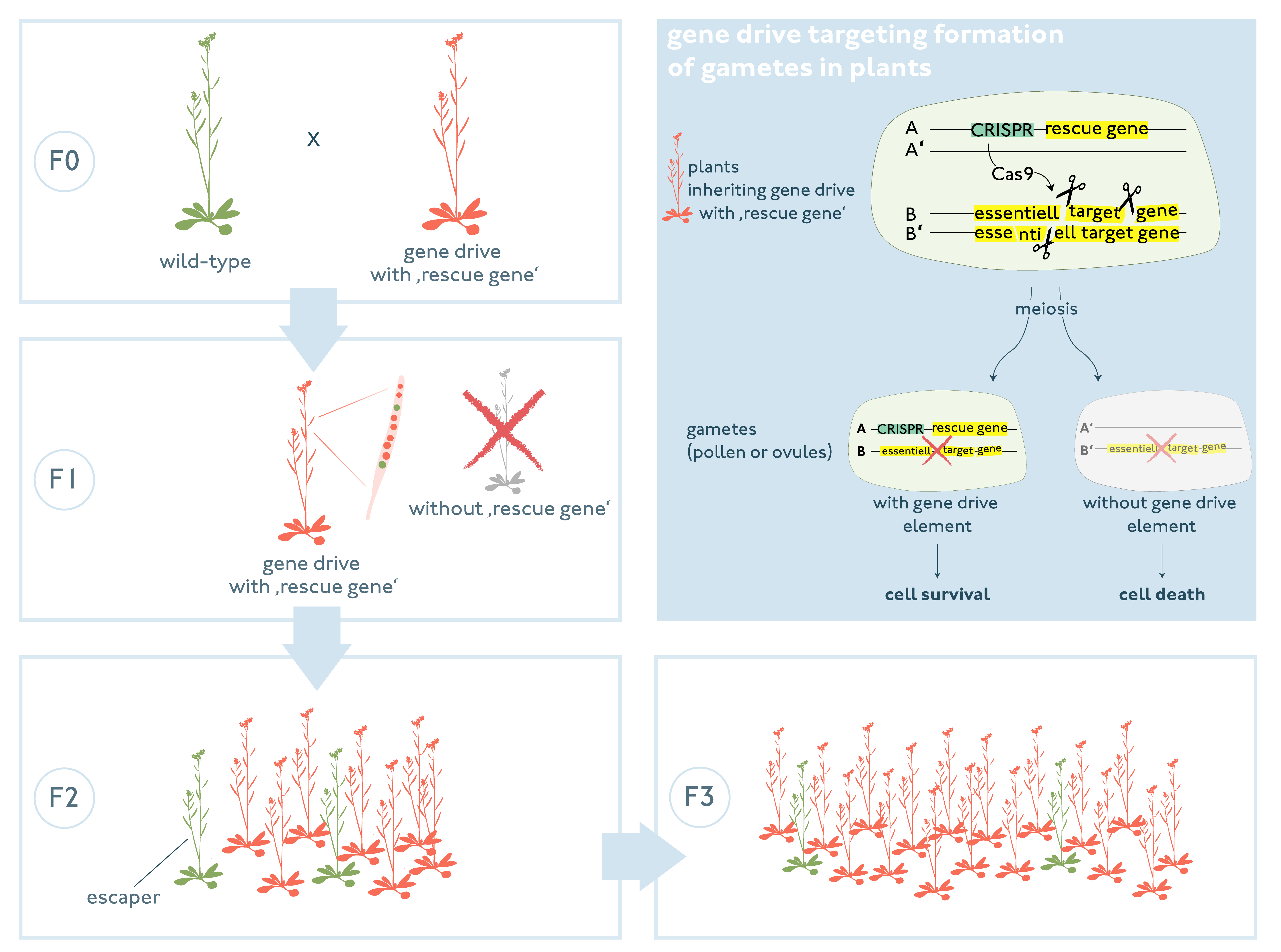With gene drive technology, a particular gene can be passed on to offspring with more than the normal Mendelian 50 % probability, thereby increasing its spread in a population. The use of gene drives is being considered for various wild organisms.

(F0) Arabidopsis thaliana wild-type plant (green) is crossed with genetically engineered A. thaliana gene drive plant containing a ‚rescue gene’ (orange). This gene drive is targeting the formation of gametes (pollen or ovules). The gene drive element comprises the gene scissors CRISPR/Cas9 and a ‚rescue gene‘. During diploid parental stage, the gene scissors cleaves a target gene on both chromosomes (B and B’) which is essential for the formation of gametes. After meiosis (in which the chromosome set is halved), only the gametes containing chromosome A survive, because the gene drive element comes with a ‚rescue gene‘ which is a cleavage-resistant copy of the target gene. Pollen or ovules can only develop if the gene drive element with the ‘rescue gene’ is passed to their genome. (F1) Offspring inheriting the gene drive element with the ‚rescue gene‘ can develop successfully. (F2) – (F3) The gene drive is transmitted to the offspring with a high inheritance rate. Only a relatively small number of ‘escaper’ with wild-type genotype is observed, caused by lack of cleavage and/or sequence alteration following cleavage (adapted and extended from: Oberhofer et al., 2024, https://doi.org/10.1038/s41477-024-01701-3).
Gene drive combining ‚cleave and rescue‘ in plants
With gene drive technology, a particular gene can be passed on to offspring with more than the normal Mendelian 50 % probability, thereby increasing its spread in a population. The use of gene drives is being considered for various wild organisms.

Upper left: (F0) Arabidopsis thaliana wild-type plant (green) is crossed with genetically engineered A. thaliana gene drive plant containing a ‚rescue gene’ (orange). Upper right: This gene drive is targeting the formation of gametes (pollen or ovules). The gene drive element comprises the gene scissors CRISPR/Cas9 and a ‚rescue gene‘. During diploid parental stage, the gene scissors cleaves a target gene on both chromosomes (B and B’) which is essential for the formation of gametes. After meiosis (in which the chromosome set is halved), only the gametes containing chromosome A survive, because the gene drive element comes with a ‚rescue gene‘ which is a cleavage-resistant copy of the target gene. Pollen or ovules can only develop if the gene drive element with the ‘rescue gene’ is passed to their genome. Middle left: (F1) Offspring inheriting the gene drive element with the ‚rescue gene‘ can develop successfully. Lower left and right: (F2) – (F3) The gene drive is transmitted to the offspring with a high inheritance rate. Only a relatively small number of ‘escaper’ with wild-type genotype is observed, caused by lack of cleavage and/or sequence alteration following cleavage (adapted and extended from: Oberhofer et al., 2024, https://doi.org/10.1038/s41477-024-01701-3).
